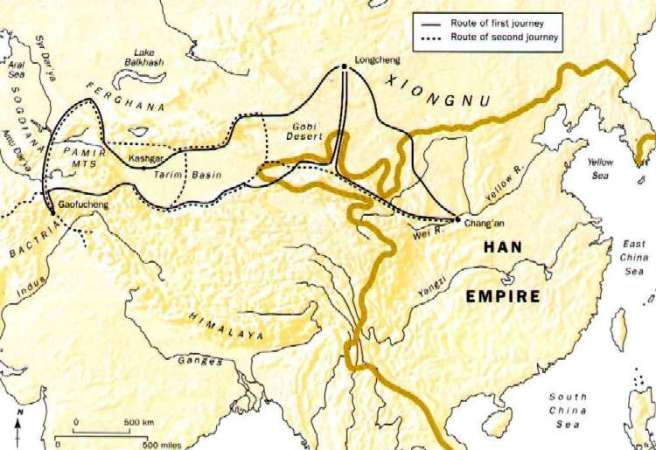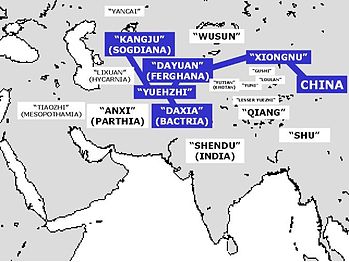Zhang Qian on the Silk Road Pencil Drawing
Zhang Qian and the Beginnings of the Silk Road
Page history last edited by afossa@umass.edu 10 months, 1 week ago
Chinese Explorer Zhang Qian on a Raft

Zhang Qian
His second century BCE travels throughout Central Asia opened trade networks that formed the early Silk Road.
Zhang Qian was a military diplomat for Emperor Wu of the Han Dynasty who traveled extensively through Asia for 10 years, gaining knowledge of different cultures, agricultural practices and goods for trade.
His travels were intended to form alliances with nomadic groups
Image above shows Zhang Qian, around 130 BCE, leaving for his expedition to Central Asia.
- Mural is from the Mogao Caves, 8th century CE
 |
| 1st & 2nd Journeys. Explorers Before Columbus blog |
The map to the right shows where Qian traveled, in blue, while the grey are places that he heard about on his travels.
Qian traveled westward enough to encounter people who were influenced by Greek culture due to Alexander the Great. In Qian's records he notes a city Dayaun, which was a city established by Alexander, named Alexandria Eschate.
Zhang Qian's travels and notes were recorded soon after his death in the Records of the Grand Historian a comprehensive history of China from the Yellow Emperor until the Han Empire.
The Silk Road
| |
| Zhang Qian in Chinese |
The historical significance of various trade routes are often noted by the exchange of tangible resources from relatively isolated regions and inherently lead to the transmission of cultures from one region to another.
TheSilk Road and theMaritime Silk Routes were actually not just one single pathway, but a branching of several land and water passages of varying topography coming from the west through Central Asia.
- Many precious commodities were traded throughout the route, from gold and ivory to animals and plants.
- Additionally, this route didn't just exist for the sole purpose of trading goods as valuable as silk, but also acted as a persuasive route to share religion--the silk route was instrumental in proliferating Buddhism from India to China.
- When the Mongols (led by Genghis Khan) began to siege territorial power through the enhanced communication that the route enabled, a significant interaction of cultural foundations of different regions took place.
- The Mongol Empire was the largest contiguous empire in world history.
- Compounding with the reality that Mongols were relatively tolerant of various religions, many nationalities and creeds were able to live in close proximity and enhance the ability to trade within the empire.
| |
| Silk Routes |
See Quanzhou: A Crucial Port along the Eastern Maritime Silk Roads from UNESCO
As a means to examine the importance of culture within these regions, the non-profit education site,The Silk Road Project supplies videos, music, and maps to help provide multicultural resources for educators.
For teaching material, see the educator section of the International Dunhuang Project: The Silk Road Online**.
This site explains the role of women in the Silk Road.
In 1453 CE, the Ottoman Turks sacked the city of Constantinople, bringing anend to the Byzantine Empire. With the newly positioned Ottomans interfering with the trade routes along the Silk Road, European leaders had to find new ways to trade for Asian commodities. The fall of Constantinople, therefore, was the fall of the Silk Road.
Zhang Qian on the Silk Road Pencil Drawing
Source: http://resourcesforhistoryteachers.pbworks.com/w/page/123938082/Zhang%20Qian%20and%20the%20Beginnings%20of%20the%20Silk%20Road

0 Response to "Zhang Qian on the Silk Road Pencil Drawing"
Postar um comentário